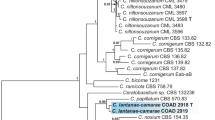Abstract
Native to Japan, Fallopia japonica, most frequently referred to as Japanese knotweed, is a highly problematic invasive weed, particularly in the UK and North America. During surveys for natural enemies of this plant in Japan, two species of Mycosphaerella were collected. One of these was identified as M. polygoni-cuspidati, and is redescribed and neotypified. Causing a damaging leaf spot disease of F. japonica throughout its natural range in Japan, it is absent from the host’s exotic range. The restriction of M. polygoni-cuspidati to F. japonica in its center of origin, together with its severe impact on host fitness, indicates that this is a coevolved natural enemy with high potential as a classical biological control agent for the long-term management of this ecologically and economically important weed. In the field, the fungus has a reduced life cycle, with only spermogonia and pseudothecia (ascomata) being formed. Ascospores are the primary source of infection, and studies show that the mycelium from in vitro cultures is also infective and hyphae penetrate mainly via the stomata. A further, undescribed species of Mycosphaerella co-occurs with M. polygoni-cuspidati, here proposed as the new species M. shimabarensis. Both species have been studied using cultural, morphological and molecular phylogenetic methods.
Similar content being viewed by others
References
Andrianova TV, Minter DM (2005) Mycosphaerella jaczewskii. IMI descriptions of fungi and bacteria 1625. CABI, Egham, Surrey
Aptroot A (2006) Mycosphaerella and its anamorphs: 2. Conspectus of Mycosphaerella. Centraalbureau voor Schimmelcultures, Utrecht
Arx JA von (1983) Mycosphaerella and its anamorphs. Proc K Ned Akad Wet Ser C 86:15–54
Bailey JP, Conolly AP (2000) Prize-winners to pariahs: a history of Japanese knotweed s.l. (Polygonaceae) in the British Isles. Watsonia 23:93–110
Beerling DJ (1991) The testing of concrete revetment blocks resistant to growths of Reynoutria japonica (Japanese knotweed). Water Res 25:495–498
Boerema GH, van Kesteren HA (1964) The nomenclature of two fungi parasitizing Brassica. Persoonia 3:17–28
Child LE, Wade PM (2000) The Japanese knotweed manual. Packard, Chichester
Crous PW, Hong L, Wingfield MJ, Wingfield BD, Kang JC (1999) Uwebraunia and Dissoconium, two morphologically similar anamorph genera with different teleomorph affinity. Sydowia 51:155–166
Crous PW, Wingfield MJ, Mansilla JP, Alfenas AC, Groenewald JZ (2006) Phylogenetic reassessment of Mycosphaerella spp. and their anamorphs occurring on Eucalyptus. II. Stud Mycol 55:99–131
Crous PW, Braun U, Groenewald JZ (2007) Mycosphaerella is polyphyletic. Stud Mycol 58:1–32
Diaz M, Hurle K (1995) Am Japanknoterich vorkommende Pathogene: Ansatz zu einer biologischen Regulierung. In: Bocker R, Gebhardt H, Konold W, Schmidt-Fischer S (eds) Gebietsfremde Pflanzenarten. Ecomed-verlag, Landesberg, pp 173–178
Fowler SV, Holden ANG (1994) Classical biological control for exotic invasive weeds in riparian and aquatic habitats-practice and prospects. In: Waal DC de, Child LE, Wade PM, Brock PM (eds) Ecology and management of invasive riverside plants. Wiley, London, pp 173–182
Goetz M, Zombach W, Boyle C (1993) Life cycle of Mycosphaerella brassicicola (Duby) Lindau and ascospore production in vitro. J Phytopathol 139:298–308
Hara K (1918) Rakuyou oyobi kareha ni kiseisuru kinrui (in Japanese). Byotyugai Zasshi 5:617
Kimura M (1980) A simple method for estimating evolutionary rates of base substitutions through comparative studies of nucleotide sequences. J Mol Evol 16:111–120
Kitamura S, Murata G (1961) Colored illustrations of herbaceous plants of Japan (Choripetalae), vol II (in Japanese). Hoikusha, Osaka
Kurose D, Renals T, Shaw R, Furuya N, Takagi M, Evans H (2006) Fallopia japonica, an increasingly intractable weed problem in the UK: can fungi help cut through this Gordian knot? Mycologist 20:126–129
Mabey R (1998) Flora Britannica. Chatt and Windus, London
Makino T (1961) Makino’s new illustrated flora of Japan (in Japanese). Hokuryukan, Tokyo
Makino T (2000) Newly revised Makino’s illustrated flora of Japan (in Japanese). Hokuryukan, Tokyo
McNeill J, Barrie FR, Burdet HM, Demoulin V, Hawksworth DL, Marhold K, Nicolson DH, Prado J, Silva PC, Skog JE, Wiersema J, Turland NJ (2006) International code of botanical nomenclature (Vienna code). ARG Gantner Verlag, Koenigstein
Nelson MR, Pound GS (1959) The relation of environment to the ringspot (Mycosphaerella brassicicola) disease of crucifers. Phytopathology 49:633–640
Punithalingam E, Holliday P (1975) Mycosphaerella brassicicola. CMI descriptions of pathogenic fungi and bacteria 468. Commonwealth Mycological Institute (CMI), Kew, Surrey
Reinhardt F, Herle M, Bastiansen F, Streit B (2003) Economic impact of the spread of alien species in Germany. Umweltbundesamt, Berlin
Saitou N, Nei M (1987) The neighbor-joining method: a new method for reconstructing phylogenetic trees. Mol Biol Evol 4:406–425
Shirai M, Hara K (1927) A list of Japanese fungi hitherto known, 3rd edn (in Japanese). Yokendo, Tokyo
Snyder WC (1946) Spermogonia versus pycnidia in Mycosphaerella brassicicola. Phytopathology 36:481–484
Sutton BC (1980) The Coelomycetes. Commonwealth Mycological Institute (CMI), Kew, Surrey
Tamura K, Dudley J, Nei M, Kumar S (2007) MEGA4: Molecular Evolutionary Genetics Analysis (MEGA) software version 4.0. Mol Biol Evol 24:1596–1599
Thompson JD, Higgins DG, Gibson TJ (1994) CLUSTAL W: improving the sensitivity of progressive multiple sequence alignment through sequence weighting, positions-specific gap penalties and weight matrix choice. Nucleic Acids Res 22:4673–4680
van der Aa HA, Vanev S (2002) A revision of the species described in Phyllosticta. Centraalbureau voor Schimmelcultures, Utrecht
Waller JM, Lenné JM, Waller SJ (2001) Plant pathologist’s pocket book, 3rd edn. CABI Publishing, Wallingford
White TJ, Bruns T, Lee SB, Taylor J (1990) Amplification and direct sequencing of fungal ribosomal RNA genes for phylogenetics. In: Gelfand M, Sninsky D, White T (eds) PCR protocols: a guide to methods and applications. Academic Press, San Diego, pp 315–322
Zhou Z, Miwa M, Nara K, Wu B, Nakaya H, Lian C, Miyashita N, Oishi R, Maruta E, Hogetsu T (2003) Patch establishment and development of a clonal plant, Polygonum cuspidatum, on Mount Fuji. Mol Ecol 12:1361–1373
Author information
Authors and Affiliations
Corresponding author
About this article
Cite this article
Kurose, D., Evans, H.C., Djeddour, D.H. et al. Systematics of Mycosphaerella species associated with the invasive weed Fallopia japonica, including the potential biological control agent M. polygoni-cuspidati . Mycoscience 50, 179–189 (2009). https://doi.org/10.1007/s10267-008-0471-z
Received:
Accepted:
Published:
Issue Date:
DOI: https://doi.org/10.1007/s10267-008-0471-z




